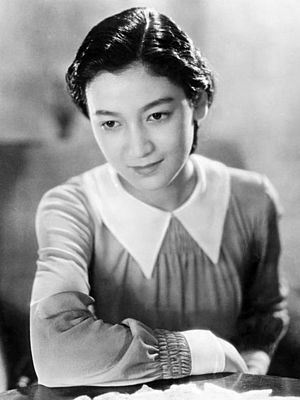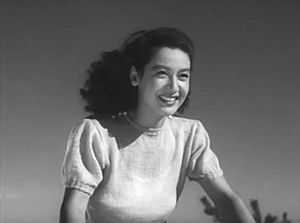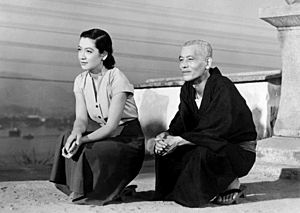Setsuko Hara facts for kids
Quick facts for kids
Setsuko Hara
|
|
|---|---|
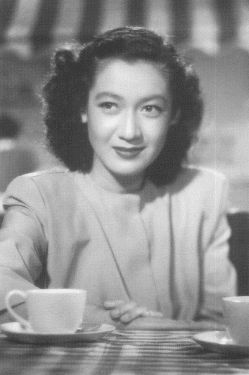
Setsuko Hara in Late Spring in 1949
|
|
| Born |
Masae Aida (会田 昌江)
17 June 1920 Yokohama, Kanagawa, Japan
|
| Died | 5 September 2015 (aged 95) Kanagawa, Japan
|
| Occupation | Actress |
| Years active | 1935–1963 |
|
Notable work
|
No Regrets for Our Youth Late Spring Early Summer Tokyo Story |
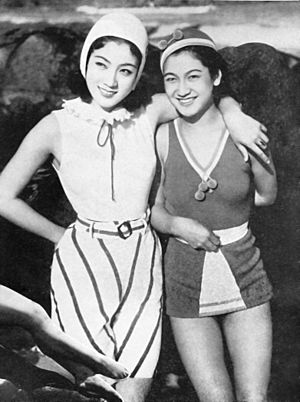

Setsuko Hara (原 節子, Hara Setsuko, 17 June 1920 – 5 September 2015) was a famous Japanese actress. She is best known for her roles in films by director Yasujirō Ozu, especially Late Spring (1949) and Tokyo Story (1953). Before working with Ozu, she had already appeared in many films.
Contents
Becoming an Actress: Early Career
Setsuko Hara was born Masae Aida in Yokohama, Japan. She came from a large family with three brothers and five sisters. Her older sister was married to a film director named Hisatora Kumagai. He encouraged Setsuko to try acting.
She left school and started working for Nikkatsu Studios in 1935. She was only 15 years old when she made her first film, Do Not Hesitate Young Folks!. The studio gave her the stage name Setsuko Hara.
Setsuko Hara became well-known after starring in a German-Japanese film called The Daughter of the Samurai (1937). This movie was also known as The New Earth in Japan. She often played sad or serious characters in her films until the end of World War II.
Postwar Films and Famous Roles
After 1945, Setsuko Hara continued to make movies in Japan. She starred in Akira Kurosawa’s first film after the war, No Regrets for Our Youth (1946). She also worked with other famous directors like Kimisaburo Yoshimura and Keisuke Kinoshita.
In some of these films, she played a "new" type of Japanese woman. This character looked forward to a bright future. However, in many of her movies, especially those directed by Yasujirō Ozu, she played traditional Japanese women. These roles included devoted daughters, wives, or mothers.
Working with Yasujirō Ozu
Setsuko Hara made six films with director Yasujirō Ozu. Their first movie together was Late Spring (1949). This partnership lasted for 12 years.
- In Late Spring, she played Noriko. Noriko was a daughter who wanted to stay home and care for her father. Her family tried to convince her to get married.
- In Early Summer (1951), she played another character named Noriko. This Noriko wanted to marry and found the courage to do so without her family's full approval.
- Her most famous film with Ozu was Tokyo Story (1953). In this movie, she played a kind widow, also named Noriko. Her husband had died in the war. Her in-laws were worried about her deep devotion to her deceased husband. They wanted her to move on and remarry.
Setsuko Hara's last major film role was in Chushingura (1962). She played Riku, the wife of a samurai leader.
Life After Acting
Setsuko Hara never married. She was sometimes called "the Eternal Virgin" in Japan. She became a symbol of the "golden era" of Japanese movies in the 1950s.
She stopped acting in 1963, the same year director Yasujirō Ozu passed away. After that, she lived a quiet life in Kamakura, Japan. Many of her films with Ozu were made in Kamakura. She refused all interviews and photos. People wondered why she left acting. Setsuko Hara once said she never truly enjoyed acting. She only did it to support her family.
Setsuko Hara died from pneumonia on September 5, 2015, when she was 95 years old. Her family did not announce her death until November 25, 2015, likely for privacy. The animated film Millennium Actress (2001) was partly inspired by her life story.
Legacy and Impact
Many film experts and directors believe Setsuko Hara was one of the greatest Japanese actresses ever. Yasujirō Ozu, who worked with her many times, praised her acting skills. He said she was "the best Japanese film actress."
Chishu Ryu, another famous actor who worked with Hara, described her as beautiful and very skilled. He said she rarely made mistakes. In 2000, Setsuko Hara was chosen by celebrities as the greatest Japanese actress of the 20th century.
Selected Films
- The Daughter of the Samurai (1937)
- No Regrets for Our Youth (1946)
- A Ball at the Anjo House (1947)
- Late Spring (1949)
- Early Summer (1951)
- The Idiot (1951)
- Repast (1951)
- Tokyo Story (1953)
- Sound of the Mountain (1954)
- Tokyo Twilight (1957)
- Late Autumn (1960)
- The End of Summer (1961)
- Chushingura (1962)
See also
 In Spanish: Setsuko Hara para niños
In Spanish: Setsuko Hara para niños


